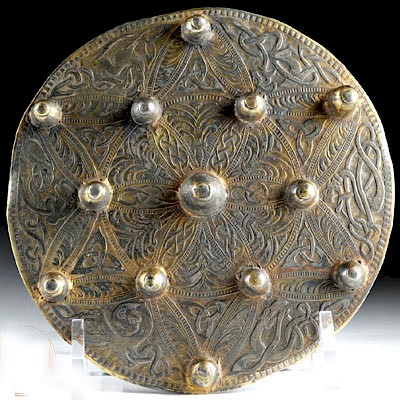Exhibited 18th C. Russian Icon - Crucifixion w/ Saints
Lot 127
About Seller
Artemis Gallery
686 S Taylor Ave, Ste 106
Louisville, CO 80027
United States
Selling antiquities, ancient and ethnographic art online since 1993, Artemis Gallery specializes in Classical Antiquities (Egyptian, Greek, Roman, Near Eastern), Asian, Pre-Columbian, African / Tribal / Oceanographic art. Our extensive inventory includes pottery, stone, metal, wood, glass and textil...Read more
Estimate:
$10,000 - $15,000
Absentee vs Live bid
Two ways to bid:
- Leave a max absentee bid and the platform will bid on your behalf up to your maximum bid during the live auction.
- Bid live during the auction and your bids will be submitted real-time to the auctioneer.
Bid Increments
| Price | Bid Increment |
|---|---|
| $0 | $25 |
| $300 | $50 |
| $1,000 | $100 |
| $2,000 | $250 |
| $5,000 | $500 |
| $10,000 | $1,000 |
| $20,000 | $2,500 |
| $50,000 | $5,000 |
| $100,000 | $10,000 |
| $200,000 | $20,000 |
About Auction
By Artemis Gallery
Jul 19, 2018
Set Reminder
2018-07-19 10:00:00
2018-07-19 10:00:00
America/New_York
Bidsquare
Bidsquare : Fine Antiquities/Ethnographic Art
https://www.bidsquare.com/auctions/artemis-gallery/fine-antiquities-ethnographic-art-3329
Featuring classical antiquities, ancient and ethnographic art from cultures encompassing the globe, plus fine art. Artemis Gallery info@artemisgallery.com
Featuring classical antiquities, ancient and ethnographic art from cultures encompassing the globe, plus fine art. Artemis Gallery info@artemisgallery.com
- Lot Description
Russia, ca. 18th century CE. An icon depicting the Crucifixion and several scriptural scenes or events from saint's lives, including Saint George slaying the dragon on the upper left, the Archangel and Saint Michael vanquishing the red devil on the upper right, and Saints Cosmas and Damian, the twin brothers who were early Christian martyrs and patrons of surgeons, physicians, dentists, veterinarians, orphanages, and protectors of children. Size: 21.25" W x 25" H (54 cm x 63.5 cm)
The Archangel Michael, depicted in a panel on the upper right, rides a winged horse over dark waters symbolizing evil. He strikes down a demon or demonic force represented by red flames with his lance. George, the legendary warrior saint and martyr depicted in the upper left panel, is shown donning armor and mounted on a horse slaying the dragon which to Christians symbolizes evil, especially paganism, outside the city walls in order to rescue the king's daughter, shown wearing a crown and royal vestments, who was being offered as a sacrifice. Hence, the conversion of a heathen country to Christianity by a saint would be depicted metaphorically this way, as the slaying of a dragon with a spear.
Originally from Arabia, the twin brothers Cosmas (depicted in the lower left panel) and Damian (depicted in the lower right panel) lived in the third century, studied medicine in Syria, and practiced in Cilicia. Cosmas and Damian were famous for spreading the Gospel through their medical practices for which they received no monetary compensation. They were beheaded under Diocletian, and by the fourth century their cult had spread throughout the Eastern Roman Empire - from Greece ot Palestine, Cappadocia to Constantinople, and then to Russia. They are often shown holding medicines and surgical instruments.
Exhibited in "Windows Into Heaven: Russian Icons from the Lilly and Francis Robicsek Collection of Religious Art" at the Mint Museum of Art, Charlotte, North Carolina (December 20, 2003 through February 22, 2004) which presented highlights of one of the world's great artistic traditions through an extraordinary group of sixty-five 18th and 19th century Russian icons on loan from the private collection of Lilly and Francis Robicsek.
Icons (icon means "image" in Greek) are sacred objects within the Eastern Orthodox Christian tradition. Found in homes as well as churches, these painted images depict holy persons and saints as well as illustrate scenes from the Scriptures. Some icons are encased in precious metal covers (oklads) adorned with pearls and semi-precious stones or glass-fronted wooden cases (kiots). Icons are not worshiped, but are instead venerated for their ability to focus the power of an individual's prayer to God. As such they are truly "windows into heaven."
The “Windows Into Heaven” exhibition profiled a magnificent chapter of Russian artistry, the embrace of the Russian Orthodox faith of religious icons during the Romanov centuries. The Russian religious faith was an offshoot of Byzantine Christianity, which in 1054 parted ways from Roman Catholicism. Icons were and continue to be religious images created for veneration. As a focus for prayers and meditation for believers, icons serve as “windows into heaven.”
Provenance: Ex-Lilly and Francis Robicsek Collection of Religious Art, Charlotte, NC; exhibited at Mint Museum of Art "Windows Into Heaven", Charlotte, North Carolina (December 20, 2003 through February 22, 2004)
All items legal to buy/sell under U.S. Statute covering cultural patrimony Code 2600, CHAPTER 14, and are guaranteed to be as described or your money back.
A Certificate of Authenticity will accompany all winning bids.
We ship worldwide and handle all shipping in-house for your convenience.
#119582Losses to peripheries as shown. Surface fissures and losses to pigment and gold leaf. Age cracks visible on verso. Back slats intact. Mint Museum label and suspension wire on verso.Condition
- Shipping Info
-
All shipping is handled in-house for your convenience. Your invoice from Artemis Gallery will include shipping calculation instructions. If in doubt, please inquire BEFORE bidding for estimated shipping costs for individual items.
-
- Buyer's Premium



 EUR
EUR CAD
CAD AUD
AUD GBP
GBP MXN
MXN HKD
HKD CNY
CNY MYR
MYR SEK
SEK SGD
SGD CHF
CHF THB
THB



















